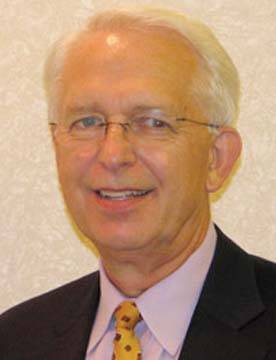This article first appeared on June 16, 2013 on ucimc.org, and we reprint it here with permission.
Several years ago, while working at our local Books to Prisoners, I met a volunteer who had formerly worked as a mental health counselor in the local jail. This was just after there had been three jail suicides within a six-month period in 2004. She recalled a time when she worked with the “Crisis Team,” a nationally-recognized mental health program that, for twenty years, prevented any suicides in the jail. In response to the three suicides, Sheriff Dan Walsh outsourced mental health services to Health Professionals Ltd. (HPL), a private company based in Peoria, Illinois. Yet this has not stopped the loss of life in the jail.
 In the current debate about whether to allocate millions of dollars toward a new jail, Sheriff Walsh (pictured left) has frequently cited the large percentage of those with mental illness (as much as twenty percent of the daily population) and argued for the need to expand the mental health facilities. More than just bricks and mortar, this issue demands that we look into quality of services provided by the private company HPL. We have something to learn from looking back at the Crisis Team, a local success story of how we can effectively treat those with mental illness.
In the current debate about whether to allocate millions of dollars toward a new jail, Sheriff Walsh (pictured left) has frequently cited the large percentage of those with mental illness (as much as twenty percent of the daily population) and argued for the need to expand the mental health facilities. More than just bricks and mortar, this issue demands that we look into quality of services provided by the private company HPL. We have something to learn from looking back at the Crisis Team, a local success story of how we can effectively treat those with mental illness.
Worth Their Weight in Gold
In August 1980, the downtown jail opened on the north side of Main Street in downtown Urbana. It replaced the jail at the sheriff’s residence, an antiquated facility built in the 1890s located east of the courthouse, what is today a parking lot. Within the first eighteen months of the new jail, there were three completed suicides. Then superintendent of the jail, Captain David Madigan, lobbied the county board to approve funding for mental health. In July 1983, the board approved a contract with the Mental Health Center of Champaign County to form what would become known as the “Crisis Team.”
A Crisis Team provided by the Mental Health Center had already been training Champaign police officers how to deal with suspects who may have had a mental illness. At first, counselors worked in the jail for forty hours per week, which by 1990 was increased to sixty hours.
Indeed, the Crisis Team was so successful that it was featured as “A Model Suicide Prevention Program” in the Winter 1990 issue of a newsletter, Jail Suicide Update, based in Mansfield, Massachusetts. According to the article, the responsibilities of the Champaign County jail were taken over in 1985 by Captain Gary Turner, who formally outlined a program for the Crisis Team that emphasized the training of personnel and assessment of those who enter the jail. Jail guards received 200 hours of training. “A correctional officer must be more caring,” Turner said, “almost displaying a social work approach to the job.”
The program also involved extensive screening of those entering the jail. Anybody showing signs of mental illness was immediately referred to Crisis Team staff. There were a range of options for housing individuals ― whether they were placed in general population, in isolation at night with partial supervision, or in complete isolation with full-time supervision.
Disputes existed between the jail administration and mental health counselors about the best approach. Captain Turner preferred isolation. Ken Bishop, a counselor, advocated for keeping those who were suicidal in general population when possible. According to Bishop, isolation almost always made the situation worse for someone who was suicidal. Others who were incarcerated often served as “unofficial” counselors to those with problems, or alerted guards of an attempted suicide.
Captain Turner cited the benefit to jail guards: “Our current prevention efforts do not put a strain on our staff, but offer a relief.” Madigan, who was elected Sheriff in December 1990, said that such mental health programs were “worth their weight in gold,” providing important services, but also saving taxpayers millions of dollars in potential lawsuits.
 With the help of Marya Burke, my co-editor on the Public i newspaper, I was recently able to track down the woman who first told me about the Crisis Team, Heidi Reible, who worked at the jail from 1992 to 2002 as a counselor and later as a supervisor. According to Reible, they had a “stellar” program. During the time she was at the jail, there were no successful suicide attempts. She recalls traveling across Illinois, speaking with state police and local agencies about the program in Champaign County. In April 2000, Reible was presented an award by U.S. Attorney General Janet Reno for a series of symposiums she organized to train police in central Illinois how to respond to those with mental illness.
With the help of Marya Burke, my co-editor on the Public i newspaper, I was recently able to track down the woman who first told me about the Crisis Team, Heidi Reible, who worked at the jail from 1992 to 2002 as a counselor and later as a supervisor. According to Reible, they had a “stellar” program. During the time she was at the jail, there were no successful suicide attempts. She recalls traveling across Illinois, speaking with state police and local agencies about the program in Champaign County. In April 2000, Reible was presented an award by U.S. Attorney General Janet Reno for a series of symposiums she organized to train police in central Illinois how to respond to those with mental illness.
At the time Reible headed the program, two full-time counselors handled approximately 100 individuals per week. There was also an on-call counselor who could assist police in the field. In a 2000 interview with The News-Gazette, Reible said counselors had a good relationship with local police, and that was uncommon:
What we do here is pretty progressive and really provides a good service to the community. I see a real common ground between law enforcement officers and social service agencies such as ours. We’re both in the community to provide a community service. (10/1/2000)
I also spoke with Sandy Lewis, former director of the Mental Health Center (she was Reible’s boss), who is now the director of a children’s treatment center in Richmond, Virginia. Lewis remembered they had an “extraordinarily successful” program in the local jail, with a 24/7 response team that conducted screenings of all inmates and coordinated care with officers. She was “very proud” of what they were able to accomplish.
New Sheriff in Town
In 2002, local attorney and former Urbana police officer Dan Walsh won an uncontested race for sheriff, replacing Madigan, who had retired. In 2004, three individuals died in the jail ― Joseph Beavers, Marcus Edwards, and Terrell Layfield. The coroner determined that all were suicides (although some still have doubts about Beavers, who sheriff’s deputies say hung himself by a phone cord in a booking cell).
As a result, there were two major changes: 1) Due to community pressure, the county board renegotiated a contract with the private company Evercom Services, which had been charging exorbitant rates for collect phone calls from the jail, making it difficult for those incarcerated to maintain contact with their families; 2) Sheriff Walsh put out a request for proposals (RFP) to expand the mental health services in the jail. In 2005, he abandoned the not-for-profit Mental Health Center in favor of a private provider, Health Professionals Ltd., a company that was already providing medical services in the jail. HPL offered 3.5 positions at a cost of $225,000 per year. The Mental Health Center had made two proposals for even more staff, but the sheriff chose HPL because they were cheaper.
Indeed, the three suicides in 2004 happened under the Crisis Team’s watch. Yet, according to Sandy Lewis, the Sheriff stressed this change was made not out of dissatisfaction with the Mental Health Center’s Crisis Team, but out of a desire to provide a higher staffing level at a cost that could be budgeted.
Despite the change in providers, there have still been several deaths in the jail. In 2006, Quentin Larry died from a heart attack after ingesting a bag of crack cocaine. A coroner’s jury, after listening to Larry’s case, recommended a “thorough review” of the screening process for those in the jail.
In 2007, Janet Hahn, a Type 1 diabetic, died in the jail. Hahn was acting erratic, had threatened suicide, and was placed in isolation at the satellite jail. After she complained, an HPL nurse used a machine to check her blood sugar, but it failed. She died shortly after of what the Coroner said was a diabetic emergency. A civil lawsuit for wrongful death filed in federal court by her husband alleged that jail guards and HPL staff ignored her calls for medical attention. Earlier this year, a judge ruled against the suit and it is currently being appealed.
In 2009, there was a successful suicide by Todd Kelly, who hung himself. After previous suicide attempts, Kelly had been placed in isolation at the satellite jail. He was let out for a short time in a recreation area where there were video cameras. Nevertheless, Kelly was able to hang himself with a bed sheet by standing on a janitor’s bucket under a stairwell, out of the sight of guards. A coroner’s jury heard the case and recommended constant observation of suicidal inmates.
There was another suicide in 2011, when Jesse Masengale hung himself in the shower area of the satellite jail. Masengale had been an activist with the Safe Haven homeless community, but later confessed to charges of child molestation. He was given thirty years by Judge Tom Difanis, after which Masengale’s attorney said his client was “shattered.” Masengale was interviewed following the sentencing by HPL staff, but they found no reason for concern. The night after he was sentenced, Masengale hung himself with the stripping of a bed sheet.
Meanwhile, Sheriff Walsh has quietly cut back the staffing hours for mental health. According to a 2009 contract with HPL, the half-time position was eliminated. The 2010 contract only allowed for 84 hours of mental health counselors, a significant rollback from the original contract, which provided for 140 hours. These reduced staffing levels have been rolled over to the present.
A recent needs assessment conducted by the Institute for Law and Policy Planning (ILPP) found that the HPL staff “does not have a substantial amount of experience working in jails.” It also states that there has been a high rate of turnover among HPL employees. Moreover, the report notes that there is no outside review for compliance with mental and medical health care standards.
Jail-Industrial Complex
How were conditions in the jail for those with mental illness allowed to deteriorate in such a short time? There was a convergence of several factors ― mass incarceration, a shrinking safety net, and the emergence of a private corrections industry ― that has led to the current crisis in the Champaign County jail.
In the last three decades, we have seen the rise of mass incarceration, largely due to the War on Drugs, leading to more than 2.3 million people in jail or prison in the United States. We can chart the growing number of people locked up locally. The daily population in the Champaign County jail went from 115 in 1985 to 158 in 1989. This growing demand led to the construction of a second jail, built in 1996 and expanded in 2003. The population continued to grow so that in 2005 there were 325 individuals held in both the downtown and satellite jails.
These were also the years when we saw an erosion of the social safety net ― the restructuring of public housing, cuts to public health, and welfare reform/deform. There was the shuttering of mental health facilities in central Illinois, with the Adolph Meyer Mental Health Center in Decatur closed in 1995, and the Zeller Center in Peoria shut down in 2002, leaving the McFarland Mental Health Center in Springfield, which only has 118 beds for the entire region. These factors have all contributed to a pressure cooker environment in the county jail.
The term “prison-industrial complex” captures the nexus of publicly-funded prisons and private companies that are profiting from the current prison boom. The increasing number of privately-run prisons has gained much attention. While private prisons are a growing trend, county jails are still publicly run. Lesser known are the many jail services that have been privatized, what might be called the “jail-industrial complex.” At the Champaign County Jail, Aramark has a contract for food and laundry services, and, as mentioned above, Evercom provides the collect phone calls.
There are several motivations for outsourcing jail services. For example, privatization shifts responsibility for training. HPL agrees to hire and train its staff, but because they are a private company, it is difficult to obtain information about the extent of the training.
Private companies also claim that they can free public bodies of legal responsibility. As the original HPL contract states in an “indemnification” clause, the Sheriff’s office is to be held harmless against legal liability. Nevertheless, they have still been sued. According to figures obtained through the Freedom of Information Act (FOIA), the Sheriff has spent a considerable amount of money to fight wrongful death lawsuits since 2005. In the case of Quentin Larry, there was an out-of-court settlement for $40,000 and attorney fees of $57,710.39. While there has been no settlement in the Janet Hahn case, it has cost $132,993.07 to litigate. The bulk of these expenses have gone to the Urbana law firm Heyl, Royster, Voelker & Allen, which currently charges $185 an hour. The belief that privatization saves money may not, in the end, prove to be true.
 HPL is no stranger to lawsuits. HPL founder and chief physician, Dr. Stephen A. Cullinan (pictured left), has had some thirty lawsuits filed against him in the last decade in Illinois alone, with at least four of them reaching out-of-court settlements. In May 2013, Cullinan received a sixty-day suspension of his medical license (although he is recently retired) and must pay a $30,000 fine for the case of a man who died from a bleeding ulcer in the Sangamon County jail. A medical malpractice lawsuit ended with a settlement of $737,500. While Champaign County has been lucky to avoid a large payout, there is the looming possibility it could happen.
HPL is no stranger to lawsuits. HPL founder and chief physician, Dr. Stephen A. Cullinan (pictured left), has had some thirty lawsuits filed against him in the last decade in Illinois alone, with at least four of them reaching out-of-court settlements. In May 2013, Cullinan received a sixty-day suspension of his medical license (although he is recently retired) and must pay a $30,000 fine for the case of a man who died from a bleeding ulcer in the Sangamon County jail. A medical malpractice lawsuit ended with a settlement of $737,500. While Champaign County has been lucky to avoid a large payout, there is the looming possibility it could happen.
HPL is a good example of the rapidly expanding private corrections industry. Founded in 1995, today HPL has contracts with more than 100 jails and prisons in 10 states, and employs some 570 people. In 2007, HPL was purchased by  Correctional Healthcare Companies, Inc. (CHC), which has its headquarters in Colorado. According to their website, two of CHC’s top executives, Don Houston and Wendy Dunegan, came from The GEO Group, one of the largest private prison corporations in the world, with prisons in Australia and South Africa. The two psychiatrists who lead CHC’s mental health services, Elizabeth Falcon and Babatunde Okuleye, formerly oversaw treatment for the 10,000 inmates at Cook County Jail, which in 2008 was condemned by the Department of Justice for systematic abuses. The chief legal counsel for CHC is Sheldon Frey, former warden of Tamms, recently closed due to a public campaign exposing its widespread human rights violations. CHC is currently responsible for nearly 70,000 inmates in more than 250 jails and prison across the country.
Correctional Healthcare Companies, Inc. (CHC), which has its headquarters in Colorado. According to their website, two of CHC’s top executives, Don Houston and Wendy Dunegan, came from The GEO Group, one of the largest private prison corporations in the world, with prisons in Australia and South Africa. The two psychiatrists who lead CHC’s mental health services, Elizabeth Falcon and Babatunde Okuleye, formerly oversaw treatment for the 10,000 inmates at Cook County Jail, which in 2008 was condemned by the Department of Justice for systematic abuses. The chief legal counsel for CHC is Sheldon Frey, former warden of Tamms, recently closed due to a public campaign exposing its widespread human rights violations. CHC is currently responsible for nearly 70,000 inmates in more than 250 jails and prison across the country.
In December 2012, CHC was subsumed by GTCR, a multi-billion dollar private investment firm in Chicago, which purchased the company for an undisclosed amount, but two other investment firms contributed $128 million. The annual contract with Champaign County for mental and medical health services is more than half a million dollars ― $517,324.68 at the time it was purchased by GTCR. Today, mass incarceration is big business.
You Get What You Pay For
 It appears there’s a growing consensus in Champaign County that mental health services should not be outsourced, but are best when kept within the community. I talked to Diane Zell, president of the local chapter of the National Alliance on Mental Illness (NAMI), who stressed the importance of local mental health providers. “We need to return to local providers at our jails,” she said, “I don’t care if it’s not as cheap.”
It appears there’s a growing consensus in Champaign County that mental health services should not be outsourced, but are best when kept within the community. I talked to Diane Zell, president of the local chapter of the National Alliance on Mental Illness (NAMI), who stressed the importance of local mental health providers. “We need to return to local providers at our jails,” she said, “I don’t care if it’s not as cheap.”
Some of the counselors hired by HPL/CHC commute to Champaign-Urbana and are not familiar with the local population of people with a mental illness. As Zell explained, “We need people who are likely to have contact with those who end up in the jail. They will have a much better idea of their needs, their medication, and are able to gain their cooperation.”
According to Zell, there is currently a failure of communication between the jail and the office in Peoria. “Often it can take 2-3 days waiting for an email response,” she said. “If services are in the same place, there is more chance to collaborate.”
Additionally, Zell argues that jail staff should receive additional training, although she recognizes it can be expensive, as someone must cover their shift. Nevertheless, Zell believes we must find funding. “You get what you pay for,” she said. “Doing something because it’s cheaper is the worst reason to do something.”
There is recent good news. On May 22, 2013, the Champaign County Mental Health Board passed a resolution to extend more services to those who get caught up in the criminal justice system. The resolution states: “We will redirect effort by modifying contracts with community based behavioral health providers to support collaboration, offer diversion options, case manage people with behavioral health needs who are incarcerated, and assure adequate and appropriate linkage to aftercare services following release.” The Board will allocate $576,884 towards prevention, of which $100,000 is new money.
I interviewed Sheila Ferguson, CEO of Community Elements, what was formerly the Mental Health Center (the name was changed in 2012). Ferguson started at the Mental Health Center in 1991 and worked for more than ten years as a crisis worker. When I told her I was doing a story about the Crisis Team, she said, “We’re doing it again; we’ve got grant dollars, and we’re headed in that direction.” As a result of the Board’s decision, they recently posted announcements for two job positions to work with individuals “before they get arrested.” They will work in the community and coordinate with local police departments. She also said there are talks to get two positions inside the jail, but that there are “contractual obligations” with HPL/CHC that are still being discussed.
Dr. Deloris Henry, President of the Champaign County Mental Health Board, told me there are plans to open a Crisis Resource Center, a place where police can drop off an individual with a mental health diagnosis. For those coming out of the jail, clinicians will refer them to local agencies for help with treatment or employment. “Right now there’s no way to track people,” said Dr. Henry. “If you went through mental health services, you should have some file. People get lost in the system. We’re hoping to close up the gaps.”
The possibility of a new jail has put a spotlight on mental health in our community. It remains to be seen whether other critical issues will be met with a similar urgency, such as the numbers showing that many are in the jail for nonviolent offenses (twenty percent for traffic offenses), or that more than half of those locked up are African American. But with the development of mental health services inside and outside the jail, we might begin to address a vulnerable population that desperately needs attention. Dr. Henry spoke optimistically: “It’s going to really be a nice start. It’s not the panacea of all the needs we have, but it’s a step in the right direction.”
This article was crowdfunded by contributions from nine individuals totaling $425.








